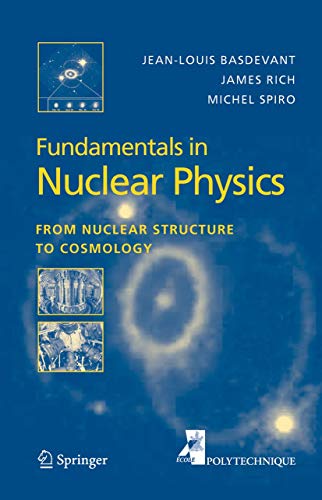Fundamentals in Nuclear Physics: From Nuclear Structure to Cosmology (Advanced Texts in Physics S) - Hardcover

Synopsis
Nuclear physics began one century ago during the “miraculous decade” - tween 1895 and 1905 when the foundations of practically all modern physics were established. The period started with two unexpected spino?s of the Crooke’s vacuum tube: Roentgen’s X-rays (1895) and Thomson’s electron (1897), the ?rst elementary particle to be discovered. Lorentz and Zeemann developed the the theory of the electron and the in?uence of magnetism on radiation. Quantum phenomenology began in December, 1900 with the - pearance of Planck’s constant followed by Einstein’s 1905 proposal of what is now called the photon. In 1905, Einstein also published the theories of relativity and of Brownian motion, the ultimate triumph of Boltzman’s s- tistical theory, a year before his tragic death. For nuclear physics, the critical discovery was that of radioactivity by Becquerel in 1896. By analyzing the history of science, one can be convinced that there is some rationale in the fact that all of these discoveries came nearly sim- taneously, after the scienti?cally triumphant 19th century. The exception is radioactivity, an unexpected baby whose discovery could have happened s- eral decades earlier. Talentedscientists,theCuries,Rutherford,andmanyothers,tookthe- servationofradioactivityandconstructedtheideasthatarethesubjectofthis book. Of course, the discovery of radioactivity and nuclear physics is of much broader importance. It lead directly to quantum mechanics via Rutherford’s planetary atomic model and Bohr’s interpretation of the hydrogen spectrum. This in turn led to atomic physics, solid state physics, and material science.
"synopsis" may belong to another edition of this title.
From the Back Cover
This course explores nuclear physics and its applications ranging from the structure of nuclei and their reactions, to astrophysics and cosmology. The physics is introduced with arguments based on simple ideas such as the empirical structure of nuclear forces and its interplay with the Pauli principle and Coulomb repulsion. The book then develops elementary nuclear models and illustrates nuclear systematics with experimental data. Reactions and decays are discussed both phenomenologically and from the point of view of fundamental electro-weak interaction theory. The discussions of fission and fusion emphasize nuclear energy production. This leads directly into nuclear astrophysics and nucleosynthesis. The book ends with a presentation of the latest ideas about cosmology. As a primer this course will lay the foundations for more specialized subjects within the vast domain of nuclear physics as a whole.
This book emerged from a series of topical courses the authors delivered at the Ecole Polytechnique and will be useful for advanced undergraduates and for scientists in a variety of fields.
"About this title" may belong to another edition of this title.
Other Popular Editions of the Same Title
Search results for Fundamentals in Nuclear Physics: From Nuclear Structure...
Fundamentals in Nuclear Physics: From Nuclear Structure to Cosmology (Advanced Texts in Physics S)
Seller: HPB-Red, Dallas, TX, U.S.A.
hardcover. Condition: Good. Connecting readers with great books since 1972! Used textbooks may not include companion materials such as access codes, etc. May have some wear or writing/highlighting. We ship orders daily and Customer Service is our top priority! Seller Inventory # S_422556215
Fundamentals in Nuclear Physics
Seller: Books Puddle, New York, NY, U.S.A.
Condition: New. pp. 532. Seller Inventory # 26280667
Fundamentals in Nuclear Physics: From Nuclear Structure to Cosmology (Advanced Texts in Physics S)
Seller: Buchmarie, Darmstadt, Germany
Condition: Good. Seller Inventory # 3775581_ad0
Fundamentals in Nuclear Physics; From Nuclear Structure to Cosmology
Seller: Burton Lysecki Books, ABAC/ILAB, Winnipeg, MB, Canada
[0-387-01672-4] 2004. (Hardcover) Near fine, no dust jacket. 515pp. Illustrations, tables, formulas, references, index. (Science, Nuclear Physics, Physics, Science). Seller Inventory # 159955
Fundamentals In Nuclear Physics : From Nuclear Structure to Cosmology
Seller: GreatBookPrices, Columbia, MD, U.S.A.
Condition: New. Seller Inventory # 3189291-n
Fundamentals in Nuclear Physics: From Nuclear Structure to Cosmology (Advanced Texts in Physics S)
Seller: Lucky's Textbooks, Dallas, TX, U.S.A.
Condition: New. Seller Inventory # ABLIING23Feb2215580170581
Fundamentals in Nuclear Physics: From Nuclear Structure to Cosmology (Advanced Texts in Physics S)
Seller: California Books, Miami, FL, U.S.A.
Condition: New. Seller Inventory # I-9780387016726
Fundamentals in Nuclear Physics: From Nuclear Structure to Cosmology (Advanced Texts in Physics S)
Seller: Ria Christie Collections, Uxbridge, United Kingdom
Condition: New. In. Seller Inventory # ria9780387016726_new
Buy New
Quantity: Over 20 available
Fundamentals In Nuclear Physics : From Nuclear Structure to Cosmology
Seller: GreatBookPricesUK, Woodford Green, United Kingdom
Condition: New. Seller Inventory # 3189291-n
Buy New
Quantity: Over 20 available
Fundamentals in Nuclear Physics: From Nuclear Structure to Cosmology
Seller: THE SAINT BOOKSTORE, Southport, United Kingdom
Hardback. Condition: New. This item is printed on demand. New copy - Usually dispatched within 5-9 working days 890. Seller Inventory # C9780387016726
Buy New
Quantity: Over 20 available

